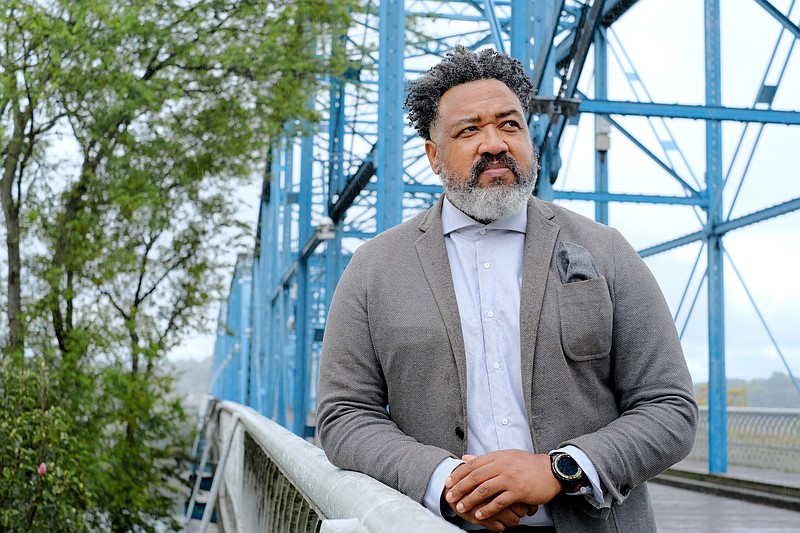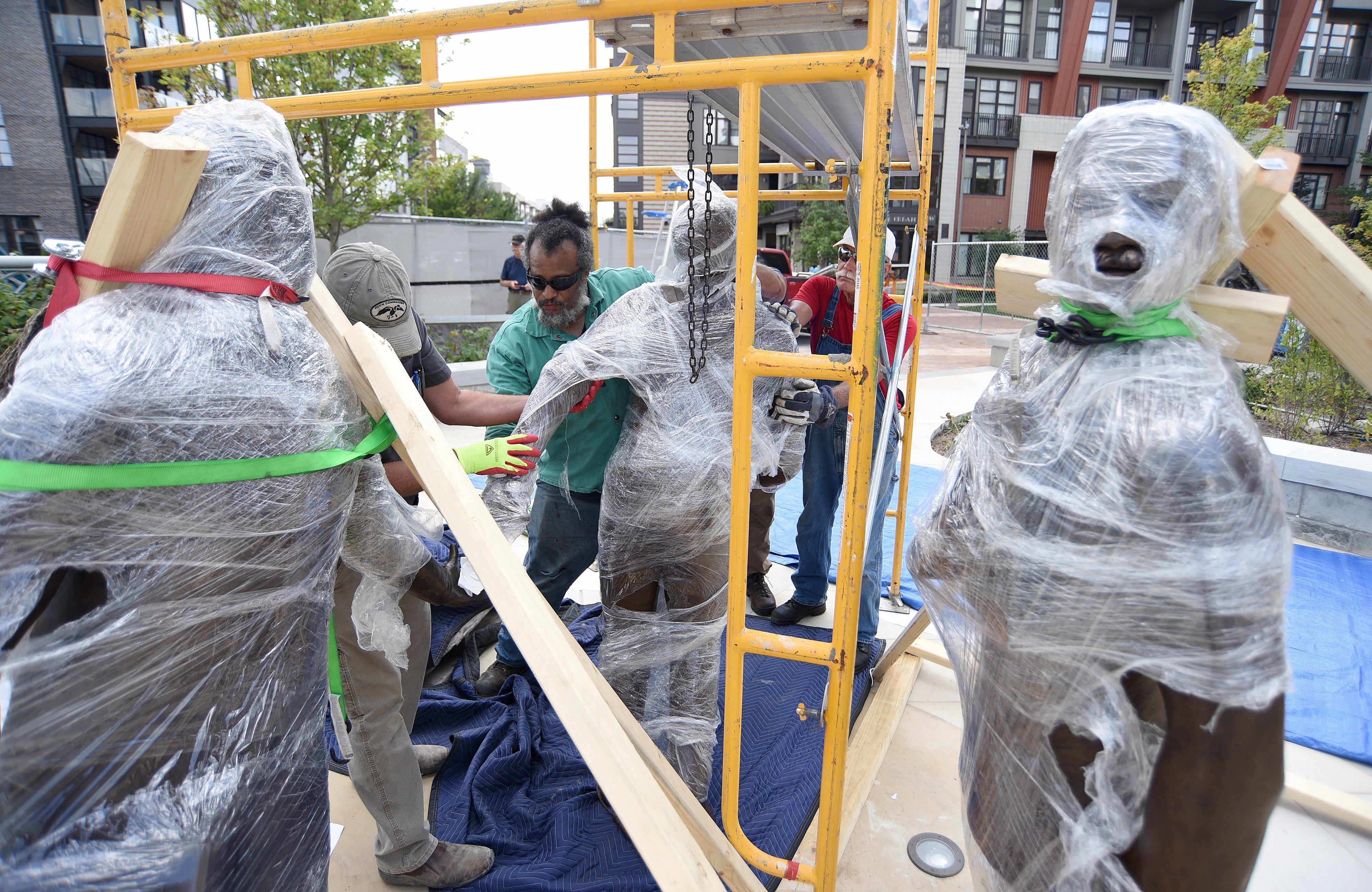Donivan Brown spent recent months visiting various monuments across the United States - the ones that memorialize the nation's most heroic moments, the ones that acknowledge its dark past.
He was drawn to the way those fixtures tell a story, how they connect the present to the past, how they change the way people see each other.
As chair of the Ed Johnson Project committee, Brown oversaw the final stretch of a yearslong effort to acknowledge the lynching of an innocent Black man on the Walnut Street Bridge 115 years ago.
On Sunday afternoon, the permanent memorial will be unveiled beside the bridge's south entrance. Crowds will gather to learn of Johnson's story and that of his two attorneys, who stood against racism and injustice.
The memorial project was a success in many ways, having gathered widespread community support. But, for those who led the charge, the work and the questions Johnson's story highlights will not end Sunday.
The Chattanooga community has an opportunity to respond.
"I think we can take that fanciful approach," Brown said, gesturing toward the memorial, "that that might be a landmark to suggest that we've ascended to the mountaintop, that we've exorcised that demon, when there are more calling out for justice."
Local leaders hope the recognition of Johnson's story can spur action on social issues still affecting local communities, particularly communities of color. But the memorial is arriving at a moment when the nation seems to be trending in two different directions, each with a different version of history and reality, Brown said.
"I'm concerned that if we don't confront our past and our present that we'll shift toward increased agitation and conflict," he said. "And this is a place, if you will, that we can bring our sins. And Ed Johnson can't make you whole, can't make you free, but I think through our process of engaging the community, of telling the truth, that we made a place where people can actually bring to bear what has happened, both past and present. And then the work continues beyond."
MAINTAINING ATTENTION
The ongoing COVID-19 pandemic is highlighting fault lines in the American health care system as the virus disproportionately affects communities of color. In Hamilton County, some of the hardest-hit ZIP codes were those with higher percentages of people of color and rates of poverty compared to the rest of the county.
The area is also grappling with questions around justice and policing. In June, a group of local clergy filed a request to the U.S. Department of Justice to investigate the Hamilton County Sheriff's Office for possible discrimination after several instances of alleged brutality by officers against people of color. The department says it is committed to fair and equitable treatment of all citizens.
An effort to defund the Chattanooga Police Department last summer in the wake of the murder of George Floyd fell mostly flat, although former Mayor Andy Berke shifted some police functions to other departments and Mayor Tim Kelly has proposed a co-response team of 10 social workers to assist the police on certain calls.
A poll by Morning Consult and Politico found that between June 2020 and May 2021 support for Black Lives Matter fell by 13 percentage points among eligible American voters, with a 14 percentage point drop in support among white voters. Black voters were the only demographic group surveyed - which included white, Black, Democratic, Independent and Republican voters - to see an increase in support for Black Lives Matter over the period.
The oscillation between white attention and white apathy is a centurieslong problem for Black Americans, said Ricardo Morris, a Chattanooga native who founded the annual Chattanooga Festival of Black Arts & Ideas. Justice for communities of color seems to only get widespread white support when doing so is easy or the topic is in vogue, he said.
"That short memory is part of the tragedy of it all," he said. "It's whatever is in the news and in front of them in the moment gets the recognition and the action. To me, that makes it more difficult when we try to deal with long-term solutions because you can't keep their attention long enough as to what now, after we've had this discussion, after we've had this march, now what?"
The memorial, and the Juneteenth celebrations that Morris organizes, provide him with a sense of belonging in the city, he said. It is a way to reclaim a bit of American history, he said, as Black residents are slowly getting more of a chance to tell their story - acknowledging the trauma as well as celebrating the triumph.
Most of the things Chattanooga promotes - the Ironman, Moon River, its tech industry - are spaces that are either not welcoming or not designed to involve Black residents, Morris said.
"We're Gig City. We're the city of innovation. We're doing all these things. We've been in the news so much for so many great things but nobody's come and walked the streets or gone into the neighborhoods or looked at whose face is on all these great things. Who's not being included in those positive things about Chattanooga?"
According to the latest census data, Chattanooga's and Hamilton County's Black populations decreased in the past decade. The city experienced a 5.8% population decrease of Black residents and the county saw a 5.2% drop between 2010 and 2020 even as both places increased in diversity.
A single factor cannot be cited as the reason for the decline, though advocates have warned gentrification, the changing job market and the increased cost of living are pushing residents from the area.
Morris, like the visual artist Jerome Meadows who designed the memorial, is drawn to the success and heroism of Johnson's attorneys, Styles Hutchins and Noah Parden. Their work, in the face of violent threats, arguing for Johnson's innocence all the way to the U.S. Supreme Court changed the American legal system.
"We really focus a lot on the fact that [Johnson] was lynched and he was innocent and what have you, but we don't put the emphasis on those brilliant attorneys who defended him," Morris said. "And is that because they were Black? And the idea that Blacks could have that type of knowledge and ability literally offends white people?"
TEACHING THE STORY
The Ed Johnson Project committee will continue researching and archiving history and continue telling the story. Linda Duvoisin, a committee member, is working on a full-length documentary about the story. The group is looking into local partnerships to keep the conversation going.
Patricia Ward Cooper worked with the committee to develop a curriculum for local teachers to share Johnson's story with students within state guidelines. The materials are designed for middle and high school students based on modules developed by the nonprofit Facing History and Ourselves, including those designed for teaching Reconstruction, "To Kill a Mockingbird" and the Holocaust.
"I tried to make it like a buffet where teachers can pick and choose what they want to use," Cooper said. "There's probably a little bit more there than they could use, so they can pick through and say, 'Oh, this would work really nice with my class.'"
In the curriculum, students learn about common beliefs and attitudes, and how those beliefs influenced people's actions. Students then examine a case study, such as Johnson's story and the legal battle, to see how those beliefs played out among various members of a community, Cooper said.
(READ MORE: Artists tell the story of Ed Johnson's Chattanooga lynching from many perspectives)
"A lot of terrible things happened. But some Chattanoogans behaved in quite beautiful, brave and moral ways to try to prevent the event from happening or to support the lawyers or the Black community coming together," she said.
It is a dynamic lesson plan, giving students the opportunity to move around the classroom as well as watch videos from experts such as Bryan Stevenson, founder and executive director of the Equal Justice Initiative based in Alabama.
Duvoisin, who is working on the Johnson documentary, shared a lot of primary sources for the curriculum, which saved time in developing the materials, Cooper said. The curriculum on Johnson's story and impact is available at edjohnsoneducation.weebly.com.
A LESSON TO REMEMBER
Eric Atkins, vice chair of the Ed Johnson Project committee, said the memorial beside the bridge can reflect the community not as it was but as it could become. When people become more aware of injustice, whether historical or contemporary, they can learn to better respond with light and love, he said.
Most tellings of Johnson's story have focused on the violence or the legal battles, Atkins said, which led some researchers to overlook how Black residents responded at the time.
The day after Johnson was murdered, Black residents refused to work. The streets were filled with protests. Thousands of people attended Johnson's funeral, forcing the event to be moved from the home of Johnson's sister to Primitive Baptist Church to accommodate the crowd.
Black residents of Chattanooga never forgot about Johnson and what happened, Atkins said. At the same time, the actions of Hutchins and Parden allowed for some semblance of justice to prevail, as the U.S. Supreme Court in its first and only criminal trial held local officials accountable for their role in the lynching.
"It's a lesson for all of us today," Atkins said. "If we want a better community and if we want a more perfect union, then we all must be all up and doing something to advance that cause."
Contact Wyatt Massey at wmassey@timesfreepress.com or 423-757-6249. Follow him on Twitter @news4mass.

